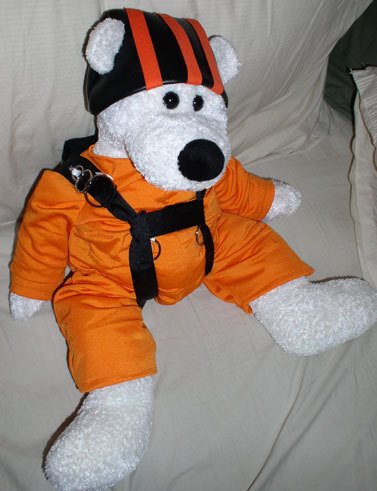Recommended Posts
Quote
Bill uses 4k as a BREAK OFF, or deployment? Most organizers use 4k as a break off. That means you have to turn and track, so you deploy around 3k.
he deploys.
I think WFFC's requirement not to be in the saddle above 3 is fine - a throw out at 3.5 meets that, still gives time to deal with issues.
I know a lot of people pressure others in a nice lemming fashion to separate at 4 and deploy at 3, but doesn't mean people have to follow. The second day I had my dytter the third alarm went off (set to 2k) when we were a bit late on our 4.5 breakoff. Seems that others just didn't track much. I was in the saddle right at 2, which is unneccesary risk for anyone (imo, of course)
Encouraging low alts because 'no one will jump with you otherwise' is as nice a practice as encouraging people to downsize.
Ron 10
QuoteEncouraging low alts because 'no one will jump with you otherwise' is as nice a practice as encouraging people to downsize.
Not trying to get off track....And I agree that jumpers should ALWAYS stay inside their comfort zone.
But it is true that some people will not jump with you if you want to break really high. YOU have the right to say no and jump on another load. Even if its wrong to pressure people....You can not ignore that it does happen.
QuoteI was in the saddle right at 2, which is unneccesary risk for anyone (imo, of course)
So I am dangerous if I am in the saddle at 2 grand? I disagree.
azdiver 0
Quote
QuoteI was in the saddle right at 2, which is unneccesary risk for anyone (imo, of course)
So I am dangerous if I am in the saddle at 2 grand? I disagree.
If you believe in an 1800' decision ceiling, planning to be in the saddle at 2 is unwise. A 1s delay in the throw or a snively or spinup on the opening and you have essentially no time to do the canopy check.
It's obviously unwise for my mal free history, but I don't see the wisdom in planning little margin for anyone else either. It's another one of those pick your risk questions - I'm content with just 11-12000 ft of freefall.
Ron 10
QuoteIt's obviously unwise for my mal free history, but I don't see the wisdom in planning little margin for anyone else either
Just like you don't think that a 4,000 break off is safe, does not mean that it is UNSAFE given more information.
2,000 feet is fine as a deployment altitude for me and a bunch of other people. It might not be good for you, thats is your call. But a 4,000 foot break off is yours and MY call as well. 4,000 feet can be a safe break off altitude, or dangerous depending on WHO is in the dive.
This right here is an example of the difference between AFF and Static line. AFF grads seem to really hate being low. Years ago when I was at a SL DZ if there were clouds at 2 grand we still jumped. Today of there are clouds at 5 grand the plane sits on the ground.
I don't think it has much to do with sl versus aff, not when/if SL jumps are done as high as 3500.
Ron 10
QuoteRon, you didn't really address my first line referencing the decision altitude. I'm interested in your thoughts there. To me, that height drives the rest of the decisions on deploy and b/o points.
I agree that the hadr deck should drive all other choices....100%
But I don't agree that 2 grand is automaticly dangerous.
QuoteI don't think it has much to do with sl versus aff, not when/if SL jumps are done as high as 3500.
SL folks do not seem to be as afraid of low altitudes as AFF folks. You are saying you like 4 grand as a deployment....Well SL folks take a delay from 4 grand.
Quote
SL folks do not seem to be as afraid of low altitudes as AFF folks. You are saying you like 4 grand as a deployment....Well SL folks take a delay from 4 grand.
I grew up at cessna DZs and launching 4 ways from 4 grand is pretty common. (Lots of cloudy days in the NW)
Nowadays you see AFF grads riding the plane down if they only get 4 grand....
Personally I think riding the plane down is more dangerous
Jumps 1-2: Static Line
Jumps 3-5: Static Line w/PRCP
Jumps 6-7: 5 second delays
Jumps 8-9: 10 second delays
Jump 10: 20 second delay
Jump 11-25: All from 10,000'. Two were 3 ways, three were 4 ways (one which got 8 points!), eight were 2 ways, 1 was first jump on the transition rig (hand deploy and smaller canopy so I pulled high (4000')), and 1 was a tracking practice jump.
$730 and a signed and stamped proficiency card later, I was a licensed skydiver.
I think it should be each individual's decision as to what they deem appropriate for their pull altitude. When I first started jumping it was 3500'. When I started doing multiple ways, we tracked at 4500, that way if I went a little low before tracking, I was still within my comfort zone. On one of my last jumps I did on the manta I made the comment to one of my instructors that either things are slowing down in my mind or it's taking longer and longer for the manta to open. After that comment they put me on the transition rig, which after about 10 jumps, also seemed to get slower and slower openings. For me, when things start to slow down in my mind, that's when I know I can go a little lower to pull because I'll be able to recognize a malfunction earlier, evaluate, react and execute a plan. But any time I downsize or change canopies, I'll increase my pull altitude again until I notice things slowing down again.
I personally think being able to do a hop 'n pop without any worries is very valuable. What if there is an a/c emergency at 2000' or 1500' feet? I know that I can leave stable and pull immediately without any problem. If I was nervous about getting out at 3500' or 4000', I couldn't imagine what would go through my mind if I had to leave at 2000' with an a/c emergency. I think it's more important to be able to do this than having more ff time.
And as for the learning "curve" of AFF vs static line, from what I read on here, AFF is like 8 jumps, then you're signed off to jump by yourself as they try to cram "everything you need to know to jump in 8 jumps", but you still have to fullfill your class A requirements. With static line (aka my experience with static line), is that you're taking one step at a time, and tend to have more instruction. For me, it's easier to learn step by step where one or two things are added, than like in AFF were many things are added to a single jump.
All just my opinion! No, you can't change it. I just just curious on how others, especially instructors, rate/compare/contrast the two.
DanG 1
I like the flexibility of the ISP in this regard. You can switch disciplines to meet certail learning goals. If your student is having difficulty with canopy control, put them out on low cost static lines with radio assistance. Freefall troubles? Transition to AFF or Tandem.
Our dropzone recently noticed that we were having fewer and fewer people graduate the AFF program. They decided to reintroduce static line at a low price and guess what, a bunch of people signed up for static line jumps. Many decided to transition to AFF after only a couple of S/L jumps, but I believe that having the lower cost option available helped people enter the sport without fear of wasting money.
BTW, I knw a young jumper (~75 jumps) who has never exited an aircraft below 10,000 ft. She is too scared. Not good.
- Dan G
NWFlyer 2
QuoteBTW, I knw a young jumper (~75 jumps) who has never exited an aircraft below 10,000 ft. She is too scared. Not good.
Especially if someone signed off on her A license card.
As for the original question, I started with SL, and ended up in a bit of a hybrid AFF/SL program because I was having trouble with exit stability on my first 5-second delays. Despite those early challenges, living in the Northwest, I've come to know and love hop & pops and will at times choose to do them even on a nice day. Lowest I've exited is about 2,500 feet - I'd rather get out higher, but I am glad I challenged myself on that day of low clouds - if I ever NEED to get out of the plane that low or lower, it's nice to know I've done it before, by choice.
azdiver 0
Guest

At mine, it was just 7 lvl's...then as many coached jumps as you need to get your A-license card signed off. Then you can go solo, or with a coach for to get your jump count to 25.
That is really sad.
azdiver 0
Eventually we will not even need airplanes anymore, we can just fly around in fishbowls with virtual reality goggles on.
Sounds like a hoot!
Quotewhys that sad thats what its built for, better trainig
It's $160 that many don't need (though I did), adding more to the cost. Your's also required the tandem, which can either add cost or save you if it means no 2 JM levels.
On bad weather days we used to practice 10 speed stars from 4500/5000 feet. Exit, dock, track and pull. The whole team would be in the saddle by 2000.
riggerrob 644
- Dan G
>>>>>>>>>>>>>>>>>>>>>>>>>>>>>>>>>
That means that her instructors skipped an important step in her AFF program.
Not good.
DanG 1
QuoteThat means that her instructors skipped an important step in her AFF program.
Not good.
I wholeheartedly agree. She did not go through her AFF at our dropzone. I don't know where she did it.
She has been strongly encouraged by the staff to do a few hop and pop's, but is resistive. Maybe they should force her to, it is not under my control.
- Dan G
Bottom line seems to be:
1. Similar costs in the long run
2. Better skills in some areas vs others
I think we're all Bozos on this bus.
Falcon5232, SCS8170, SCSA353, POPS9398, DS239
Ron 10
Quotepopsjumper---IMO, I don't think it got too off topic. The discussion regarding hnp's and pull altitude are related to the differences in AFF and S/L.
Agreed.
QuoteI'd be curious if there are any other discussions that could stem from an AFF vs S/L debate.
Packing and spotting skills.






Bill uses 4k as a BREAK OFF, or deployment? Most organizers use 4k as a break off. That means you have to turn and track, so you deploy around 3k.
Share this post
Link to post
Share on other sites